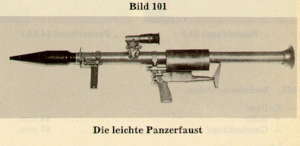| Leichte Panzerfaust 44 mm "Lanze" | |
|---|---|
 PzF 44 | |
| Type | Anti-tank rocket launcher |
| Place of origin | West Germany |
| Service history | |
| In service | 1963–1992 |
| Used by | See Operators |
| Production history | |
| Designed | 1960 |
| Manufacturer | Dynamit Nobel |
| Produced | 1963–1992 |
| Variants | See Variants |
| Specifications | |
| Mass | Unloaded: 7.82 kg (17 lb 4 oz) Loaded: 10.12 kg (22 lb 5 oz) |
| Length | Unloaded: 880 mm (2 ft 11 in) Loaded: 1,180 mm (3 ft 10 in) |
| Cartridge | 44×537mm rocket cartridge |
| Caliber | Barrel: 44 mm (1.7 in) Warhead: 67 mm (2.6 in) |
| Muzzle velocity | At muzzle: 168 m/s (550 ft/s) At max Vo: 210 m/s (690 ft/s) |
| Maximum firing range | ~ 400 m (1,300 ft) |
| Sights | Telescope |
The PzF 44 (abbreviation for Panzerfaust 44 mm, formally also Leichte Panzerfaust,[1] meaning "Light tank-fist", also known as Panzerfaust Lanze (lance) and Panzerfaust 2/Panzerfaust II), was a West German portable recoilless shoulder-fired anti-tank rocket launcher with a barrel-caliber of 44 mm (1.7 in). It was the spiritual successor to the Panzerfaust from World War II and served with the West German Army from the early 1960s to the early 1990s, when it was replaced by the Panzerfaust 3 semi-disposable launcher.
The PzF 44 is called "recoilless" in the sense that it ejects propellant gas rearwards of the chamber upon firing, so called backblast, and not because it truly lacks recoil. Backblast heavily counters recoil but does not fully remove it. The effect of the minimized recoil however is great enough to allow a portable weapon like this to fire large caliber warheads without causing trauma to the user.
YouTube Encyclopedic
-
1/3Views:33 9396571 339
-
The Powerful German Panzerfaust 3 Anti-Tank Weapon In Action
-
Panzerfaust 44 Manual #Shorts
-
German Panzerfaust Anti-tank Weapons Armored Tank Capability Test
Transcription
History
The anti-tank grenade launcher was originally developed around 1960 and put into service by the Bundeswehr in 1963. It was developed to provide West German infantry with a modern replacement for the Bazooka that they had previously used. As such, it was the first German antitank rocket developed after World War II, a conflict in which German hand-held antitank weapons such as the Panzerfaust played a prominent role during 1944–45. The PzF 44 was a product of a period in which the German army was re-equipped with locally developed arms and equipment and retired the aging U.S. gear that had formed their initial arsenal. The full designation name by the German Army is Panzerfaust 44mm DM2 Ausführung 1 Lanze.[citation needed]
Some PzF 44 were used by Nigerian Army during the Biafran War.[2]
Starting in 1992, the PzF 44 was replaced by the Panzerfaust 3.
Specifications
The PzF 44's 1.5 kg (3.3 lb) high-explosive anti-tank (HEAT) cartridge (Panzerfaustgeschoß DM32)[3] could penetrate 370 mm (15 in) of rolled homogeneous armour and hit moving targets at a range of 300 m (980 ft). The PzF 44 could also fire a multi-purpose warhead.[4]
| Weapon | Cartridge | Penetration vs RHA | Max range vs moving target |
|---|---|---|---|
| PzF 44 | PzF-gesch DM32 | 370 mm (1 ft 3 in) | 300 m (330 yd) |
| RPG-7 | PG-7V rocket | 320 mm (1 ft 1 in) | 300 m (330 yd) |
| M72 LAW | Rocket HE 66MM M72 | 305 mm (1 ft 0 in) | 150 m (160 yd) |
Variants
- Model 44-1 – Initial version of the PzF 44.
- Model 44-1A1 – Later version of the PzE 44–1.[1]
- Model 44-2 – Later model of the PzF 44.[6]
- Model 44-2A1 – Model 44–2 with different sight mount.[6]
Operators
See also
- Panzerschreck – (Nazi Germany, Germany)
- Panzerfaust 3 – (West Germany)
- PSRL-1 – (United States of America)
- Armbrust – (West Germany)
- MATADOR – (Singapore)
- RPG-2 – (Soviet Union)
- RPG-7 – (Soviet Union)
References
- ^ a b Kurzbeschreibung der Leichten Panzerfaust (Panzerfaust 44 mm), Modell 44-1A1 (in German). West Germany. 1963 – via YouTube.
{{cite book}}: CS1 maint: location missing publisher (link) - ^ a b Jowett, Philip (2016). Modern African Wars (5): The Nigerian-Biafran War 1967-70. Oxford: Osprey Publishing Press. p. 20. ISBN 978-1472816092.
- ^ ZDV 3/16 - Die Leichte Panzerfaust (in German). West Germany: Bundesministerium der Verteidigung. 1980. pp. 130–132.
- ^ "The PzF-44 Panzerfaust II "Lanze"". chainlinkandconcrete.blogspot. Retrieved 2022-01-16.
- ^ Jane's Infantry Weapons 1984-85.
- ^ a b "The "West German RPG-7"". defense-and-freedom.blogspot.com. 22 July 2010. Archived from the original on 2020-09-29. Retrieved 2022-01-16.
External links
- Jane's extract on the PzF 44
- Leichte Panzerfaust Model 44-2 & 2A1 manual on scribd.com
- PzF 44-2A1 ordnance scan on valka.cz
